Related Research Articles
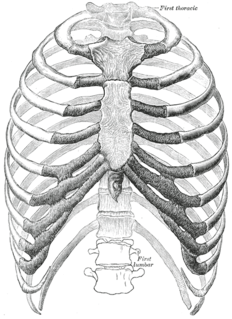
In vertebrate anatomy, ribs are the long curved bones which form the rib cage, part of the axial skeleton. In most tetrapods, ribs surround the chest, enabling the lungs to expand and thus facilitate breathing by expanding the chest cavity. They serve to protect the lungs, heart, and other internal organs of the thorax. In some animals, especially snakes, ribs may provide support and protection for the entire body.

Hello, Love is a 1959 studio album by the American jazz singer Ella Fitzgerald, recorded over two sessions in 1957 and 1959.
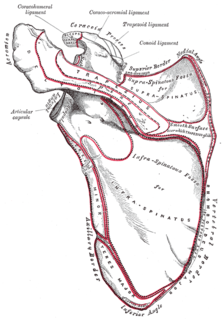
Ewart's sign is a set of findings on physical examination in people with large collections of fluid around their heart.

Costovertebral angle (CVA) tenderness is pain that results from touching the region inside of the costovertebral angle. The CVA is formed by the 12th rib and the spine. Assessing for CVA tenderness is part of the abdominal exam, and CVA tenderness indicates kidney pathology.

The costovertebral joints are the joints that connect the ribs to the vertebral column. The articulation of the head of the rib connects the head of the rib to the bodies of the thoracic vertebrae.
Costovertebral may refer to:

The inferior costal facet is a site where a rib forms a joint with the inferior aspect of the body of a thoracic vertebra.
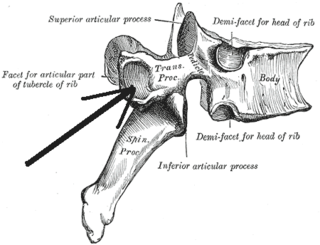
The transverse costal facet is one of the costal facets, a site where a rib forms a joint with the transverse process of a thoracic vertebra.

The costal margin, also known as the costal arch, is the lower edge of the chest (thorax) formed by the bottom edge of the rib cage.
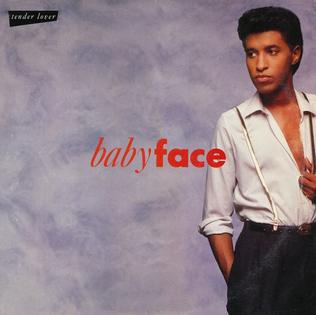
Tender Lover is the second studio album by American R&B singer-songwriter and musician Babyface. It is the follow-up to his debut Lovers (1986). It was his first album with SOLAR after the label entered into a distribution deal with Epic Records. In some regions of Europe, Tender Lover was released with a different cover picture and simply titled Babyface.

Spondylocostal dysostosis, also known as Jarcho-Levin syndrome (JLS), is a rare, heritable axial skeleton growth disorder. It is characterized by widespread and sometimes severe malformations of the vertebral column and ribs, shortened thorax, and moderate to severe scoliosis and kyphosis. Individuals with Jarcho-Levin typically appear to have a short trunk and neck, with arms appearing relatively long in comparison, and a slightly protuberant abdomen. Severely affected individuals may have life-threatening pulmonary complications due to deformities of the thorax. The syndrome was first described by Saul Jarcho and Paul M. Levin at Johns Hopkins University in 1938.

The elbow is the region between the upper and lower parts of the arm that surrounds the elbow joint. The elbow includes prominent landmarks such as the olecranon, the elbow pit, and the lateral and the medial epicondyles of the humerus. The elbow joint is a hinge joint between the upper arm and the forearm; more specifically between the humerus in the upper arm and the radius and ulna in the forearm which allows the forearm and hand to be moved towards and away from the body.

The Charles L. Manson House is a Frank Lloyd Wright designed home in Wausau, Wisconsin. The house was listed on the National Register of Historic Places on April, 5, 2016. Reference Number, 16000149.
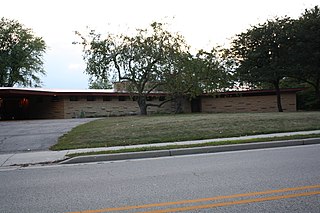
The E. Clarke and Julia Arnold House is a Frank Lloyd Wright designed Usonian home in Columbus, Wisconsin, United States.

Sangam is a live album by jazz saxophonist Charles Lloyd recorded in Santa Barbara, California in May 2004 by Lloyd with Zakir Hussain, and Eric Harland.
Walter L M Russ was a 1,538 GRT cargo ship built in 1927 in Rostock, Germany. In 1945, she was seized by the Allies and passed to the Ministry of War Transport (MoWT). It was intended that she would be renamed Empire Concourse but in July 1945 she ran aground between Wales and Ireland, and was wrecked.
Lépine's sign is one of the medical signs of gallbladder disease. It is positive when effleurage with crooked third finger at the point of the gallbladder projection to anterior abdominal wall elicits pain. It is not to be confused with the following:

The costovertebral angle is the acute angle formed on either side of the human back between the twelfth rib and the vertebral column.
In geometric optics, the angle of incidence is the angle between a ray incident on a surface and the line perpendicular to the surface at the point of incidence, called the normal. The ray can be formed by any wave: optical, acoustic, microwave, X-ray and so on. In the figure below, the line representing a ray makes an angle θ with the normal. The angle of incidence at which light is first totally internally reflected is known as the critical angle. The angle of reflection and angle of refraction are other angles related to beams.
Mathe's sign is an ultrasonographic sign that suggests the existence of an abscess in the proximity of a kidney. Normally during inspiration when standing, the kidneys move distally to some extent. When one of them does not move at all or moves downwards scarcely, either in erect position or deep inspiration, the test is called positive. Along with fever, urinary symptoms, and costovertebral angle tenderness, this will almost always indicate a perinephric abscess.
References
- ↑ M.D, Mark E. Williams (2009). Geriatric Physical Diagnosis: A Guide to Observation and Assessment. McFarland. p. 185. ISBN 9780786451609 . Retrieved 23 November 2017.